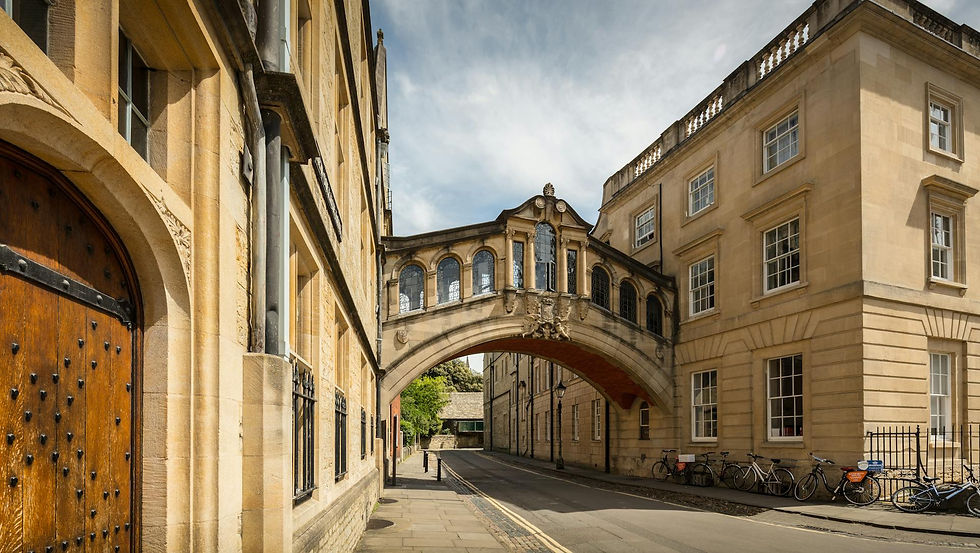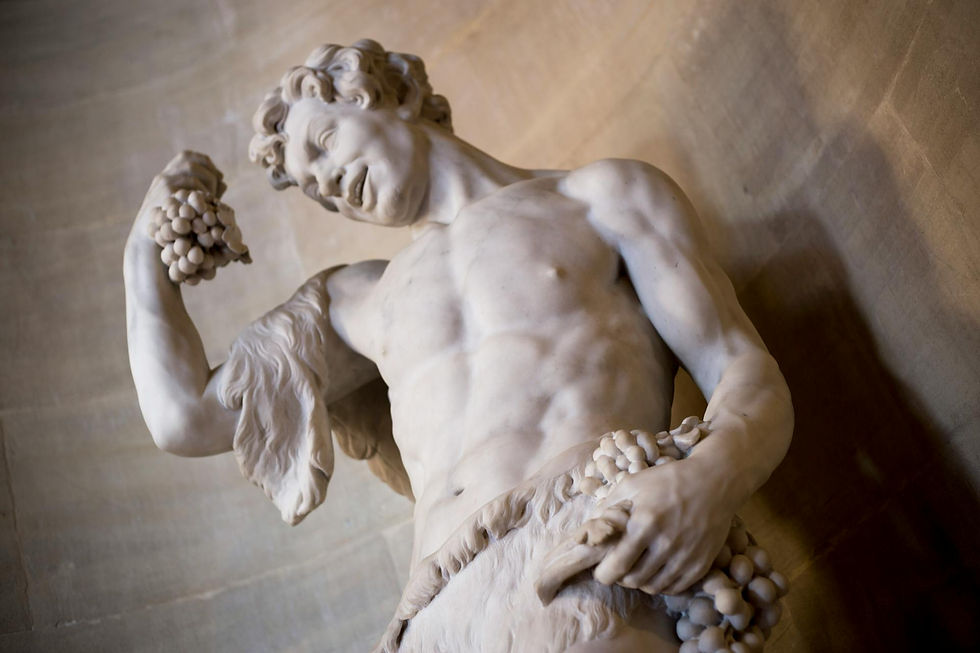Oxford, Up Close: A Journalist’s Deep-Guide for Curious Visitors
- Jeffrey Allen

- Aug 22
- 6 min read
Step off the train at Oxford and you’re in a city where scholarship has shaped the streets for nearly a millennium. It’s compact enough to walk end-to-end, yet layered with museums, medieval lanes, colleges, libraries, markets, meadows—and a palpable sense that ideas have always been the real currency here. This guide is built for travelers who want to go beyond the postcard and understand how to see Oxford like an informed insider—what to prioritize, how places fit together, and where the details matter.
Start at the heart: the Bodleian complex, one of Europe’s great libraries and a functioning research engine as well as a visitor magnet. Public access to working reading rooms is limited, so the smartest way in is to book a Bodleian guided tour. The brisk 30-minute option delivers the essentials and, crucially, gets you inside Duke Humfrey’s Library, Oxford’s oldest reading room, plus the fan-vaulted Divinity School; the 60-minute version adds Convocation House and the Chancellor’s Court, where 17th-century discipline (and on one famous occasion, parliament itself) played out. Tours sell out in peak months—reserve early.
Duke Humfrey’s itself is a time capsule: long, narrow, oak-lined, and still in use by researchers today. It’s named for Humphrey of Lancaster, 1st Duke of Gloucester, who donated 281 manuscripts that seeded Oxford’s scholarly future. The room you see has been restored and extended over centuries, but its core purpose—quiet, rigorous reading—never changed. Photography rules vary on tours; expect hushed voices and a sense of ceremony the moment you cross the threshold.
Step outside and the skyline is suddenly theatrical. On one side: the Divinity School’s stone filigree, studded with hundreds of carved bosses; on the other, the perfectly round Radcliffe Camera, one of Britain’s most photographed buildings. Despite its fame, it isn’t a museum—it’s a working library and home to the History Faculty Library, linked by the underground Gladstone Link to the Old Bodleian. That’s why you’ll see readers’ cards being checked at the door. Admire it respectfully from Radcliffe Square, where cobbles and college walls compress centuries into a single view.
For a literal overview, climb the tower of the University Church of St Mary the Virgin, a few steps away on the High Street. The 13th-century tower is one of Oxford’s classic vantage points, with wraparound views of Radcliffe Square, All Souls’ golden finials, and the sweep of the High. It’s a narrow stair—127 steps—and popular on clear days, but the panorama at the top explains Oxford’s famous “dreaming spires” nickname better than any quote could.
Oxford’s museums are unusually strong for a city this size. The Ashmolean, founded in 1683, calls itself the world’s first university museum; admission is free, and the collections range from Egyptian sculpture to Pre-Raphaelite painting and contemporary photography. A recent highlight is Fra Angelico’s Crucifixion, acquired after a major fundraising effort—an example of how the museum keeps augmenting its historic holdings. Plan at least 90 minutes and save time for the ceramics and European galleries, which are compact but deep.
If you prefer your anthropology in Victorian glass cases, the Pitt Rivers Museum—entered through the Oxford University Museum of Natural History—remains one of Britain’s most distinctive spaces. Its “typology” displays (think “fire-making,” “body modification,” “masks”) present objects from many cultures side-by-side, asking you to compare function before geography. Families love it, scholars mine it, and first-timers often linger far longer than planned. Check the “Highlights” and “Visit Us” pages for current displays and family-friendly trails.
Between institutions, give yourself permission to wander. Oxford rewards detours down Turl Street and Holywell Street, pauses in college quadrangles (when open), and a coffee stop in the Covered Market, the 18th-century arcade where independent traders have worked under one roof for over 250 years. It began in 1774 with butchers’ stalls, designed by John Gwynn (who also drew Magdalen Bridge), and today it’s a browseable maze of produce, bakeries, flowers, and quick lunches. If you’re looking for “old Oxford” flavour without ticket lines, this is it.
Colleges are living communities, not theme parks, so visiting etiquette pays off: check entry times, expect small admission fees, and respect “closed to visitors” signs during exams and events. If you visit just one, make it Magdalen (pronounced “MAWD-lin”). Set beside the River Cherwell, it has cloisters, a chapel with celebrated choral tradition, a water meadow rimmed by Addison’s Walk, and—uniquely—a deer park with a resident herd. In spring, the meadow’s fritillaries bloom; in summer, guided tours sometimes reach spaces not usually open to the public.
From Magdalen Bridge, Oxford’s most timeless pastime beckons: punting. Hire a flat-bottomed punt and pole yourself up the Cherwell past reed beds and willows, or let a professional chauffeur do the work while you watch college towers slide by. Magdalen Bridge Boathouse sits right by the High; Cherwell Boathouse is a pretty 15–20 minute riverside walk north with a celebrated restaurant and its own fleet of hand-built punts. On sunlit afternoons it can feel like an Edwardian painting come to life.
Not everything in Oxford is showpiece architecture. The city’s texture emerges in smaller spaces: the Weston Library (part of the Bodleian) for changing exhibitions of manuscripts and maps; the Sheldonian Theatre’s painted ceiling and occasional concerts; the Bridge of Sighs (really Hertford Bridge) as a quick photo-stop; and quiet green escapes like Christ Church Meadow and the University Parks. For an easy “mix and match” half-day, pair the Bodleian tour with the University Church tower, then drift to the Covered Market for lunch and finish with an Ashmolean circuit.

Practicalities matter here. Working libraries are exactly that—working—so parts of the Bodleian complex require reader cards for entry, and the Radcliffe Camera is for registered readers only. Tours create a structured window for visitors and are adjusted day-to-day for events and closures; check the “Plan Your Visit” page for daily changes, especially in summer. The same logic applies to colleges: Magdalen posts seasonal hours and occasional guided tour info; other colleges may close during term rituals or ceremonies. Build a loose plan, then verify a day or two ahead.
A word on pacing: Oxford is dense with content, but distances are short. You can sample the Bodleian, climb the tower, browse the market, and add one museum in a single day without feeling rushed. Two days lets you see a second museum (Natural History + Pitt Rivers pair well), tour a college, and try punting. If it’s raining (it often is), the Ashmolean’s free entry and cafes are a dependable refuge; when the sun breaks through, nothing beats a slow loop on Addison’s Walk or a meander through the Market’s arcades.
Context deepens the visit. The Bodleian isn’t just photogenic; it’s a civic brain that helped standardize scholarship long before the modern university took shape, and Duke Humfrey’s was the model reading room where chained books once ensured that knowledge stayed put. The Radcliffe Camera’s circular form—built as a science library, long before it housed historians—speaks to Oxford’s centuries-old habit of repurposing beautiful spaces without fossilizing them. And the museums tell a complementary story: the Ashmolean inventing the university museum concept in the 17th century; the Pitt Rivers capturing a 19th-century anthropological mindset in three soaring, shadowed tiers.
Food and drink? Keep it simple. The Covered Market is your go-to for quick, local options; beyond that, you’ll find pubs and cafes everywhere between Broad Street and St Giles’. If you’ve punted from Cherwell Boathhouse, linger on the terrace; if you’re near Magdalen at dusk, the bells and choir can turn the walk back along the High Street into a small piece of theater. (And if you’re chasing “what locals actually do,” it’s often: a museum hour, a riverside walk, and something easy in the Market.)
If you have a third day, push out of the core: climb Carfax Tower for a different city view; visit Modern Art Oxford for contemporary exhibitions; or hop to Blenheim Palace (20 minutes by bus from central Oxford) for baroque scale and Capability Brown landscaping—best when the weather cooperates. But you don’t need to overcomplicate it. Oxford’s gift to visitors is concentration: in a few square blocks you can see how learning shaped a city and how that city, in turn, made learning feel inevitable.

Before you go, a checklist for “smart Oxford”:
Reserve the Bodleian tour that fits your tempo; confirm on the day for any last-minute changes. visit.bodleian.ox.ac.uk
Plan one elevated view (University Church tower) for orientation. University Church of St Mary the Virgin
Pick one museum deeply (Ashmolean or Pitt Rivers/Natural History pairing) rather than skimming all. ashmolean.orgprm.ox.ac.uk
Choose one college well (Magdalen for landscape + architecture) and verify hours. magd.ox.ac.uk
Leave time to wander the Covered Market and side streets—Oxford rewards serendipity. Oxford Covered Market
If the sun comes out, punt. It’s cliché because it’s delightful. Magdalen Bridge BoathouseCherwell Boathouse

You’ll depart with the usual photographs, yes, but also with a sense that Oxford is not simply “old”—it’s actively used. Students still queue for books under carved ceilings; curators still acquire and interpret; markets still bustle; and the rivers still carry punts past meadow and tower. In a world of set-piece tourism, Oxford is wonderfully, stubbornly alive.













Comments